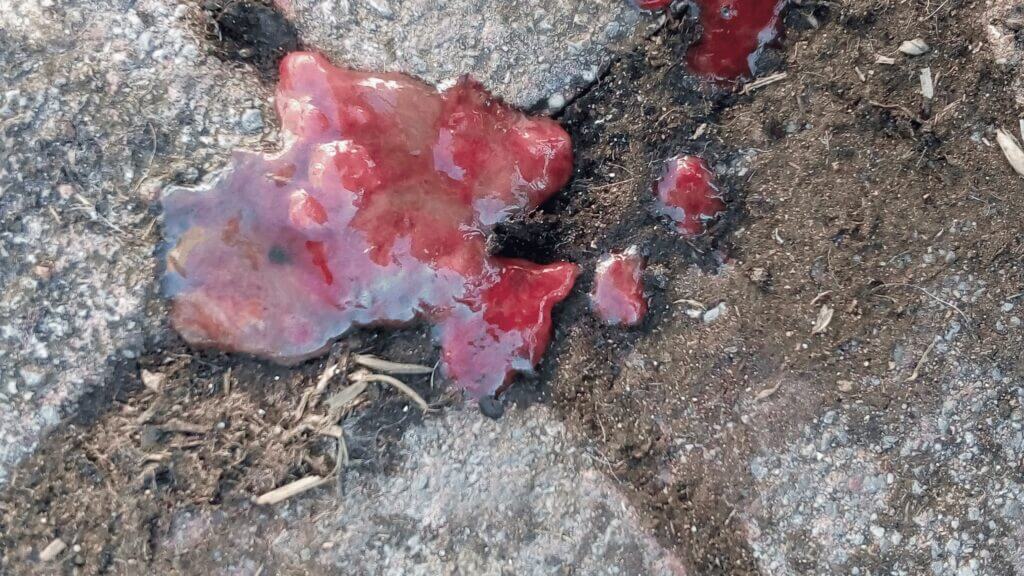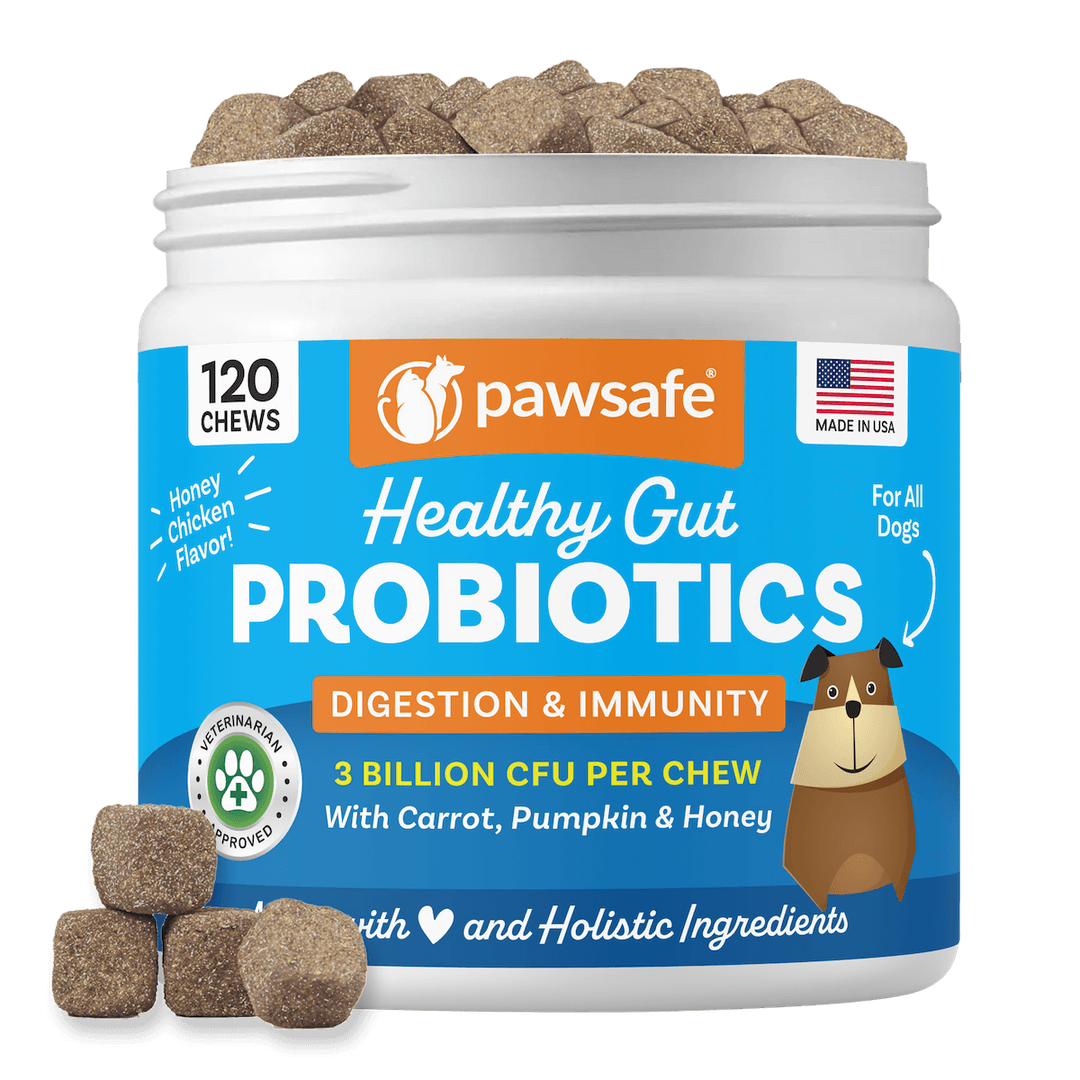
“Why is my dog’s poop red?” is one of the most concerning questions pet owners ask themselves and the internet, especially when you see signs of blood. The reasons behind bloody poop in dogs can sometimes be mild and easy to treat, but other times need an emergency vet visit.
Our canine buddies can’t tell us when they are not feeling well or what’s wrong. This leaves it to us to pick up on any telltale signs, including a change in the color or texture of their poop. The good news is that red or bloody poop in dogs is not always life-threatening. Some bloody poop cases can be solved with something as easy as a diet change and supplements like canine probiotics.
The severity of your dog’s reddish stool depends on factors like how much blood, other signs, and the exact shade. To really get into the issue of bloody dog poop, we consulted the work of Dr. J. S. Suchodolski[1] from Texas A&M University. So, before letting the panic kick in, read along for these nine possible causes of blood in poop in dogs to know what to do next. Warning: this article contains pictures of various kinds of bloody or red dog poop.
Table of Contents
- So, Why Is My Dog's Poop Red?
- Bright Red Dog Poop Versus Dark Red Or Black Dog Poop
- 13 Reasons Why A Dog's Poop May Be Red or Contain Blood
- Why is My Dog Pooping Blood But Acting Perfectly Normal?
- Help! My Dog is Pooping Blood and Vomiting!
- What Should I Do If My Dog Poops Blood Or Red Poop?
- Frequently Asked Questions (FAQs)
- Final Thoughts
- References
So, Why Is My Dog’s Poop Red?
Red dog poop usually means blood in the feces or eating food with red dye, like beets. Blood in your dog’s poop can indicate severe conditions like bacterial and viral infections (like parvo), intestinal obstruction, and hemorrhagic gastroenteritis. Less severe causes of bloody poop include allergies, ulcers, parasites, colitis, Addison’s disease, and eating something bad.
A canine’s stool can offer valuable insight into what’s happening in their body since a dog’s gut is about 70% of their immune system. Red dog poop can mean many different things, so it’s vital to take it into context and ask yourself the following questions to relay the answers to your vet:
- Is the poop bright red, or is it dark and tarry?
- Is there a lot of slime on your dog’s soft stool?
- Is the dog pooping a lot in one go, or is it frequently and little bits?
- Are there droplets of blood covering the poop, or is all the poop stained red?
- Is the poop solid or watery (diarrhea)?
- Is your dog’s poop red and bloody, but otherwise, they’re acting normally?
- Or are there other symptoms, such as refusing to eat, vomiting, or lethargy?
Upon seeing blood in your dog’s stool, your immediate thought is whether your pup is in pain. Well, precisely what your dog is feeling depends on the underlying cause of the stool color. No matter the severity of the reason, the first step is remaining calm since panic undermines judgment.
There are countless stool oddities most dogs will encounter in their lifetime. Whether it’s yellow poop or white dog poop, you can expect a poo situation on your hands at some point. Some abnormalities go away independently, but others are way more stubborn.
Bright Red Dog Poop Versus Dark Red Or Black Dog Poop
The first thing to look at with red is the dark poop shade of red, whether bright red or dark. There are two types of bloody stools in dogs, hematochezia and Melena, categorized based on the shade of red. Hematochezia refers to bright red blood that you will instantly recognize as blood. Melena, on the other hand, is dark, sticky, and can have a black or tarry appearance.
Hematochezia (bright red blood in the poop) often occurs in the lower digestive tract, while Melena (dark red blood) occurs in the upper. Essentially, bright red poop or obvious blood droplets usually means blood comes from the lower intestines or the anus because the body has not yet digested it.
Dark red poop, on the other hand, means the blood has moved through the digestive tract, which signals it comes from the stomach or upper intestines. In the picture below, you can see an example of dark red or blackish dog poop.

One study[2] refers to these conditions as gastrointestinal hemorrhage or bleeding in the gut. It also states that these conditions can result in acute, possibly life-threatening anemia if the dog loses too much blood internally. So never ignore blood in the poop.
Most people refer to hematochezia when they say their dog is pooping blood since it’s the easiest to see. This is definitely what sends most pet parents into a full panic.
However, melena, or dark, tarry stool, is often the most dangerous, although both warrant prompt medical attention. So let’s get into the reasons for red poo, whether it’s dark or bright red.
13 Reasons Why A Dog’s Poop May Be Red or Contain Blood
Bloody poop ranges from infection and parasites to trauma and foreign objects. We have categorized these reasons into those that typically cause upper digestive tract bleeding (hematochezia) and lower GI bleeding (Melena).
However, several of these reasons, like trauma, toxins, parasites, and infections like parvo, can cause both types of bloody or red poop. Most, if not all, of these reasons are accompanied by other signs like vomiting, diarrhea, lethargy, and refusing to eat.

Let’s get right into the potential causes of this pesky red color change in your dog’s poop.
1. Hematochezia (Bright Red Dog Poop) Causes
Eating Something Bad, resulting in Hemorrhagic Gastroenteritis
Most dogs are not fussy eaters, happy to eat everything from socks to old tuna in the garbage, even if it means harming themselves. When a dog eats something that does not agree with them, they may shed both blood and mucus from their gut, which shows up as slimy poop that is red or has blood. This can happen from:
- Eating something rancid from the trash or in the park;
- Eating something they have a food intolerance to, such as some food additives or spices;
- A food allergy;
- Changing diets too suddenly (always take at least two weeks to change your dog’s food); or
- Swallowing something in the gut that has damaged the stomach lining and made it bleed.
Such dietary indiscretion can sometimes result in explosive bloody diarrhea and vomiting, which are both symptoms of hemorrhagic gastroenteritis (HG) (bleeding in the gut). In severe cases, this can progress to watery diarrhea.
While we don’t know all the causes of HG, research[3] has shown that dietary changes play a significant role. So dogs may get HG from eating human foods high in fats, bony food, or too many treats.
2. Colitis (Colon Inflammation)
Colitis refers to an inflammation of the colon, which can result in traces of blood in the poop. The condition is also responsible for most chronic diarrhea. Colitis is also called garbage disease, and it’s very common in puppies who tend to eat all kinds of things they shouldn’t. We want to address colitis first because puppy parents often see colitis poop and assume their puppy has parvo.
Luckily, colitis is nowhere near as serious, and your vet can clear it up quickly with a bland diet and some medication. It just means something is aggravating your dog’s colon, causing it to shed mucus (you will notice a lot of slime covering the poop) and blood. The blood will usually cover the poop or show up as droplets on the stool. Probiotics can help restore gut balance during colitis treatment.
The picture below shows what the blood in the poop of a puppy with colitis usually looks like. Notice that there is usually a lot of slime or mucus with the blood.

You may also notice that even if your dog has blood on their poop, they act fine and seem healthy. They want to play and have no trouble eating. They may have soft or watery stools and want to poop often (usually only in small amounts). These are typical signs that your dog or puppy has colitis. This is easy to treat, and if you’re worried about parvo, you can take a sigh of relief.
Irritable bowel syndrome (IBS) or Inflammatory bowel disease (IBD) is a similar condition that can also cause inflammation in the bowel, which may be another cause of blood in the poop.
3. Bacterial and Viral Infections (Including Parvovirus)
Some viral and bacterial infections in dogs attack the GI lining, leading to blood in poop and liquid diarrhea. The most common infectious disease causing blood is parvo, characterized by the bitter-sweet parvo poop smell.
Parvovirus in dogs[4] is life-threatening, and you must take your dog to the vet immediately, as time is of the essence. Unlike colitis, you will notice other symptoms like vomiting, lethargy, dehydration, and liquid poop. The poop is watery, may contain, blood, but it may also be yellowish and even foamy. The picture below is an example of what parvo poop looks like:


Daily Support For Healthy Digestion
Multi-strain probiotic soft chews that help maintain gut balance and stool quality in an easy, tasty format.
Shop Now 👉Vet Approved Formula • 90-Day PawSafe® Promise
4. Parasite Infestation
Some parasites, like hookworms, roundworms, and whipworms, can be more severe than we credit them, burrowing into intestinal linings and causing bleeding. Parasites don’t just cause the bloody red poop, but also dark, depending on where they lodge themselves. Looking carefully, you can see white specs in the poop, just wriggling and existing.
5. Trauma Resulting in Internal Bleeding
Many people immediately interpret blood in poop as an injury, and they’re right. In fact, as you googled this question, you may think your pup was hit by a car or involved in an accident. Trauma can result in internal bleeding that reveals itself as streaks of blood in the poop.
The severity of the trauma impact determines the other signs you’ll see. Very extreme traumatic injuries may display as bleeding from the mouth or pale gums. However, tumors and several other disorders can cause internal bleeding in the abdomen, called hemoabdomen[5] (blood in the gut). Hemoabdomen or internal bleeding is life-threatening, so see a vet immediately.
6. Anal Gland Inflammation Or Fissures
Dogs express their anal glands naturally every time they poop. However, those with ongoing diarrhea or very loose stool may have impacted and infected anal sacs. Anal gland issues like abscesses, swelling, and infection may manifest as bloody poop and a metallic smell.
Anal fissures[6] or ulcers around a dog’s anus is another painful condition that causes blood on the poop, and this will usually be bright red. The symptoms of anal fissures are very similar to colitis, as your dog may poop little but often and show signs of pain when pooping. Be sure to ask your vet to check for both when you see bright red blood on your dog’s stools.
7. Red Foods Or Red-Dyed Items
One possible reason for red dog poop is simply that your dog ate something red, and does not mean there is any blood in the poop. This could be anything from beets to red crayons. So keep an eye on anything red your dog may have ingested that causes red poop that is not blood but just something your dog ate.
The natural dyes in food like beets are so vital they can even give your dog red or pink pee, called beeturia. It can also make poop look bloody when it’s not.
Melena (Dark Red Dog Poop) Causes
Dark and old blackish-red poop has unique causes that can be more severe than bright red. Some reasons like trauma, parasites, IBS, IBD, and Hemorrhagic Gastroenteritis that we’ve discussed above also cause Melena[7]. Here are a few other causes unique to Melena or digested blood in dog poop.
8. Toxins
Ingestion of toxins like chocolate, pesticides, rat poison, and antifreeze often causes dark, tarry poop in dogs. Poisoning in dogs[8] is life-threatening, requiring immediate medical attention. While dark poop is most common, you can also see bright, red blood when a dog is poisoned. Other signs include extreme vomiting, disorientation, and weakness.
Below is a video of a dog that has been poisoned and needs immediate veterinary attention:

Gut & Immune Support In One Chew
Targeted strains assist normal digestion while supporting natural immune defenses—simple once-a-day routine.
Shop Now 👉Vet Approved Formula • 90-Day PawSafe® Promise
9. Ingesting Foreign Objects
Objects like sticks, bone fragments, and toys are not just choking hazards but can also cause bleeding. This happens when the objects scratch the GI lining, and the blood makes its way to the poop. Your dog can also injure the mouth and swallow the blood, which leads to bloody stool when digested.
10. Stomach Ulcers in Dogs
Anything that causes bleeding in the upper digestive tract or stomach can cause dark red or black tarry stools. Stomach ulcers[9] in dogs are one culprit. If a dog has a stomach ulcer, aside from Melena, or dark stool, you may also see:
- Vomiting (sometimes with blood);
- Weight loss;
- Drooling;
- Refusing to eat;
- Fever; and
- Pale gums.
11. Liver and Kidney Failure and Stomach Tumors
In the case of liver failure, blood can’t flow through the liver properly. This causes pressure to build and the vessels to rupture, causing blood in the stool.
Liver failure can cause all sorts of excretory changes, including weird ones like green urine.
Stomach Tumors (both cancerous and noncancerous) can inflame the GI lining, causing red stool.
12. Pancreatitis
Pancreatitis is a rare cause[10] of blood in a dog’s stool and is believed to result from too much fat consumption. Swelling of the pancreas due to pancreatitis can cause intestinal bleeding causing stool color to change and become red or cause dark red to blackish feces.
13. Addison’s Disease
Addison’s disease[11], or hypoadrenocorticism, is another rare cause of dark red blood in the poop. Addison’s disease often causes gastrointestinal bleeding and Melena. This is often underdiagnosed in dogs because the symptoms of Addison’s disease look so much like other problems. So if your dog has dark red or black stools and these symptoms, ask your vet to check their adrenal glands for Addison’s disease.
- Weakness or apathy;
- Lack of interest in food;
- Weight Loss;
- A lot of trembling or shaking (including shaking back legs);
- Drinking more water than usual and peeing more than usual; or
- Diarrhea and/or vomiting.
Why is My Dog Pooping Blood But Acting Perfectly Normal?
Your dog pooping blood but acting normal is unusual and typically means they aren’t in pain or feeling sick. Normal behavior, even with bloody poop, often suggests mild issues your dog can deal with, like parasites, allergies, colitis, and food intolerance. But it would help if you still saw the vet to have the issue checked out.
Remember, one must question what "acting perfectly normal " means. For example, your dog not eating for two days but still moving around and not whimpering in pain isn’t exactly normal.
On the other hand, your dog acting normal can also mean they’re stoic and really good at hiding pain. Ultimately, watching signs and knowing your dog is crucial if they appear okay, even with blood in their poo.

Make Digestive Care Effortless
Palatable soft chews your dog looks forward to, helping keep things regular and comfortable over time.
Shop Now 👉Vet Approved Formula • 90-Day PawSafe® Promise
Help! My Dog is Pooping Blood and Vomiting!
Extreme diarrhea with blood and vomiting is often a sign of parvo or another life-threatening condition. This is especially true for unvaccinated puppies, young adults, or those with incomplete shots.
Other causes of blood in stool and vomiting are IBS. IBD, stomach ulcers, and gastroenteritis. Bloody poop with other signs like vomiting warrants a vet visit as soon as possible, particularly if the symptoms persist.
What Should I Do If My Dog Poops Blood Or Red Poop?
Seeing your vet and collecting a poop sample for them to test is the best step if your dog has red poop or signs of blood. Other steps you can take include:
- Administer anti-parasite medication, especially if you see specs in the stool.
- Give your dog the necessary antibiotics as prescribed by the doctor.
- Watch your dog closely during walks to prevent them from ingesting foreign objects
- Keep toxic substances like grapes and chocolate away from your dog’s reach
- Monitor their diet closely in case it causes a reaction
- Again, go to the vet if your dog has concerning signs like not waking up and vomiting
Frequently Asked Questions (FAQs)
Is Blood in My Dog’s Poop an Emergency?
Blood in your dog’s poop may not immediately land them in the ER, but it calls for an urgent vet visit to make sure. Red poop often suggests major issues like trauma, liver failure, parvo, and other severe problems that subside with medical attention. Not all conditions that cause red poop in dogs are life-threatening, but your vet does need to make a diagnosis for safety’s sake.
Can Certain Foods Cause Blood in a Dog’s Poop?
Food intolerance often causes diarrhea without blood, but some foods, like too many bones, can cause red poop if they damage the stomach lining. It’s also possible for your dog to experience reddish diarrhea after a diet change, like one causing allergies. Food that contains natural or artificial dyes, like beets, can cause red poop in dogs.
Final Thoughts
Bloody poop is significantly more severe than other colors like yellow or white. It’s best to get to the vet as fast as possible if you see your dog’s poop turning red or see signs of blood. Even though not all red poop is life-threatening, your dog needs to see a vet to diagnose and treat the issue.
References
- COMPANION ANIMALS SYMPOSIUM: Microbes and gastrointestinal health of dogs and cats1. Oup. https://academic.oup.com/jas/article/89/5/1520/4764596
- Gastrointestinal Hemorrhage. PMC. https://www.ncbi.nlm.nih.gov/pmc/articles/PMC7152172/
- Hemorrhagic Gastroenteritis - an overview. ScienceDirect. https://www.sciencedirect.com/topics/veterinary-science-and-veterinary-medicine/hemorrhagic-gastroenteritis
- Canine Parvovirus Infection (Parvoviral Enteritis in Dogs) - Digestive System - MSD Veterinary Ma.... MSD Veterinary Manual. https://www.msdvetmanual.com/digestive-system/diseases-of-the-stomach-and-intestines-in-small-animals/canine-parvovirus
- MedVet Blog. Medvetforpets. https://www.medvetforpets.com/hemoabdomen-in-dogs/
- Anal fissures in dogs – what’s going on? - Vet Help Direct. Vethelpdirect. https://vethelpdirect.com/vetblog/2022/09/26/anal-fissures-in-dogs-whats-going-on/
- Melena - an overview. ScienceDirect. https://www.sciencedirect.com/topics/veterinary-science-and-veterinary-medicine/melena
- Common dog poisons | Health | Dogs | Animal Welfare Victoria | Livestock and animals. Gov. http://agriculture.vic.gov.au/livestock-and-animals/animal-welfare-victoria/dogs/health/common-dog-poisons
- Stomach and Intestinal Ulcers in Dogs. Petmd. http://petmd.com/dog/conditions/digestive/c_dg_gastroduodenal_ulcer_disease
- Chronic pancreatitis as a cause of gastrointestinal bleeding.. Bmj. http://gut.bmj.com/content/gutjnl/23/3/250.full.pdf
- Addison's disease. Cornell. https://www.vet.cornell.edu/departments-centers-and-institutes/riney-canine-health-center/health-info/addisons-disease







